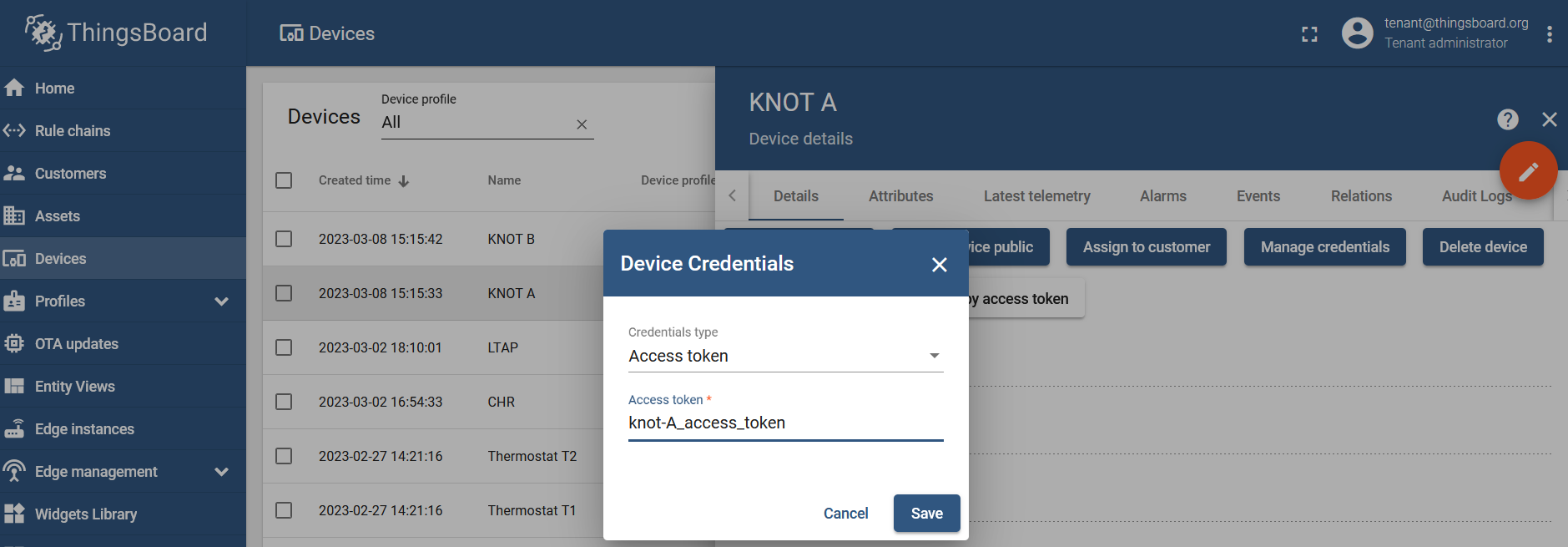...
Set up a unique access token (unique credentials) for each KNOT under the device you've just created, under the "Manage credentials" tab:
RouterOS configuration
Preparation
Before setting everything up, we need to confirm that our Bluetooth tag, actually appears in the KNOT's Bluetooth range and that the KNOT detects them. To do that, you can issue the command:
| Code Block | ||
|---|---|---|
| ||
[admin@MikroTik] > iot bluetooth scanners advertisements print
# DEVICE PDU-TYPE TIME ADDRESS-TYPE ADDRESS RSSI LENGTH DATA
0 bt1 adv-noconn-ind mar/08/2023 12:35:15 public 2C:C8:1B:4B:BB:0A -50dBm 22 15ff4f090100b0110100ffff00000019d68d2300005d
1 bt1 adv-noconn-ind mar/08/2023 12:35:16 public DC:2C:6E:0F:C0:3D -39dBm 22 15ff4f0901008f3cfcfffbfffaff301783c22c000064
2 bt1 adv-noconn-ind mar/08/2023 12:35:35 public 2C:C8:1B:4B:BB:0A -50dBm 22 15ff4f09010084d500000400ffff0319ea8d2300005d
3 bt1 adv-noconn-ind mar/08/2023 12:35:45 public 2C:C8:1B:4B:BB:0A -50dBm 22 15ff4f090100e607faffffff03000319f48d2300005d
4 bt1 adv-noconn-ind mar/08/2023 12:35:46 public DC:2C:6E:0F:C0:3D -39dBm 22 15ff4f090100773ffcff000000004017a1c22c000064
5 bt1 adv-noconn-ind mar/08/2023 12:35:55 public 2C:C8:1B:4B:BB:0A -41dBm 22 15ff4f090100d88000000600ffff0319fe8d2300005d |
Or you can check it using Webfig or Winbox under the IoT>Bluetooth>Advertising reports tab.
The list can be chaotic. Random payloads can appear on the list as the scanner captures everything around it. So, to confirm that your actual tag is within the range, apply a tag's MAC address filter:
| Code Block | ||
|---|---|---|
| ||
> iot bluetooth scanners advertisements print where address=DC:2C:6E:0F:C0:3D
# DEVICE PDU-TYPE TIME ADDRESS-TYPE ADDRESS RSSI LENGTH DATA
0 bt1 adv-noconn-ind mar/08/2023 12:41:06 public DC:2C:6E:0F:C0:3D -49dBm 22 15ff4f0901005ab20100fdfffdff4017e1c32c000064
1 bt1 adv-noconn-ind mar/08/2023 12:41:26 public DC:2C:6E:0F:C0:3D -40dBm 22 15ff4f090100349704000000fcff4017f5c32c000064
2 bt1 adv-noconn-ind mar/08/2023 12:41:36 public DC:2C:6E:0F:C0:3D -49dBm 22 15ff4f09010073fb0000000000003017ffc32c000064
3 bt1 adv-noconn-ind mar/08/2023 12:41:46 public DC:2C:6E:0F:C0:3D -43dBm 22 15ff4f090100b88cffffffffffff401709c42c000064
4 bt1 adv-noconn-ind mar/08/2023 12:41:56 public DC:2C:6E:0F:C0:3D -39dBm 22 15ff4f0901006863feff0000ffff401713c42c000064
5 bt1 adv-noconn-ind mar/08/2023 12:42:06 public DC:2C:6E:0F:C0:3D -49dBm 22 15ff4f090100952e01000300feff40171dc42c000064
6 bt1 adv-noconn-ind mar/08/2023 12:42:16 public DC:2C:6E:0F:C0:3D -41dBm 22 15ff4f090100d025000000000100401727c42c000064 |
MQTT broker
On each KNOT setup MQTT broker.
For KNOT A:
| Code Block | ||
|---|---|---|
| ||
/iot/mqtt/brokers/add name=tb address=x.x.x.x port=1883 username=knot-A_access_token |
Where:
nameis the name that you wish to give to the broker and this name will be used later in the script;addressis the IP address of the broker/ThingsBoard server;portis the TCP port that the broker is listening for → for non-SSL it is typically TCP 1883;usernameis dictated by the MQTT broker and, in our case, it is an "access token" that was generated in the ThingsBoard management portal.
For KNOT B → Do the same step. Just change the username to the respective access token that was generated for the KNOT B device (gateway).
Script
Import the script show below:
| Code Block | ||
|---|---|---|
| ||
/system/script/add dont-require-permissions=no name=mqttgps owner=admin policy="ftp,re\ boot,read,write,policy,test,password,sniff,sensitive,romon" \ source=" ###Configuration###\r\ \n #Enter pre-configured broker's name within \"\":\r\ \n :local broker \"tb\"\r\ \n #Enter the topic name within \"\", per the broker's config\ uration:\r\ \n :local topic \"v1/devices/me/telemetry\"\r\ \n\r\ \n ###Variables####\r\ \n :global lat\r\ \n :global lon\r\ \n :global alt1\r\ \n :global alt2\r\ \n\r\ \n ###GPS####\r\ \n :put (\"[*] Capturing GPS coordinates...\")\r\ \n /system gps monitor once do={\r\ \n :set \$lat \$(\"latitude\");\r\ \n :set \$lon \$(\"longitude\");\r\ \n :set \$alt1 \$(\"altitude\")}\r\ \n ###remove \"meters\" from the value because JSON format wi\ ll not understand it###\r\ \n :set \$alt2 [:pick \$alt1 0 [find \$alt1 \" m\"]]\r\ \n\r\ \n :local message \\\r\ \n \"{\\\"latitude\\\":\$lat,\\\r\ \n \\\"longitude\\\":\$lon,\\\r\ \n \\\"altitude\\\":\$alt2}\"\r\ \n\r\ \n ###MQTT###\r\ \n :if (\$lat != \"none\") do={\\\r\ \n :put (\"[*] Sending message to MQTT broker...\");\r\ \n /iot mqtt publish broker=\$broker topic=\$topic message=\$\ message} else={:put (\"[*] Lattitude=none, not posting anything!\ \");:log info \"Latitude=none, not posting anything!\"}"/iot/mqtt/brokers/add name=tb address=x.x.x.x port=1883 username=access_token |
